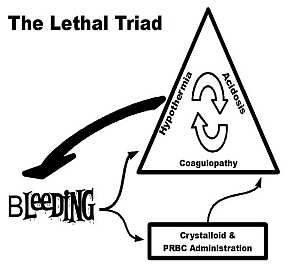Lessons in Transport - The Lethal Triad
/To successfully resuscitate the critically ill trauma patient we must have an understanding of and a respect for the LETHAL TRIAD of TRAUMA...
Bleeding causes acidosis, coagulopathy, and hypothermia...
Acidosis and hypothermia causes more coagulopathy which causes more bleeding... and so begins a deadly cycle
Causes of Hypothermia
FACT: Hypothermia decreases coagulation factor activity by 10% for each degree decrease in core temperature
Environmental factors: prolonged extrication time, wind, snow, rain etc.
Cold IV fluids
Ongoing blood loss
Exposing the patient for prolonged and repeat physical exams.
***PEARL***
Remember our elderly and pediatric patients are even more at risk to become hypothermic after trauma
Causes of Acidosis
FACT: Acidosis reduces fibrinogen levels, platelet counts, and Factor Xa
Decreased perfusion leading to anaerobic metabolism and lactic acid production
Resuscitation with crystalloid IV fluids. (pH of Normal saline is around 4.5-5.5 and the pH of LR is around 6.0)
Ongoing blood loss
Incorrect use of the ventilator resulting in a respiratory acidosis on top of an existing metabolic acidosis
Causes of Coagulopathy
Don't forget about our patients on anti-platelet therapy, coumadin, and other novel anticoagulants
How we combat the lethal triad
Stop hemorrhage when possible (tourniquet, combat gauze, pelvic binder, etc.)
Keep the patient warm. Limit exposure to the environment. Expose only the necessary portion of the patient when performing a physical exam.
Limit crystalloid infusion: it is acidotic and dilutes clotting factors (however if you had to give crystalloid make sure it is warm)
Volume resuscitate with blood products... after all we don't bleed saline.
Permissive hypotension also known as hypotensive resuscitation
Administer tranexamic acid... see last weeks Lessons in Transport for more information
More on trauma in the coming weeks...





